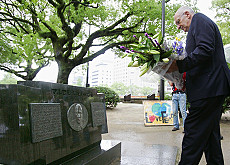
Couchepin lays wreath at Hiroshima

Interior Minister Pascal Couchepin has officially commemorated the 220,000 victims of the two atomic bombs dropped on Japan, the first Swiss minister to do so.
Couchepin also paid homage to Swiss doctor Marcel Junod, one of the most accomplished field delegates in the history of the International Committee of the Red Cross (ICRC), who was the first foreign doctor to reach the bombsite at Hiroshima.
On Saturday Couchepin laid a wreath in the Hiroshima Peace Park in memory of delegates of the ICRC, according to Couchepin’s spokesman Jean-Marc Crevoisier.
Couchepin described the two atomic bombs dropped by the United States on Hiroshima and Nagasaki in August 1945 as a dramatic part of history that was a “warning for everyone”.
“Never again atomic weapons,” he told Swiss television.
“Terrifying sight”
Also in the Hiroshima Peace Park Couchepin visited a monument to Neuchâtel-born Junod, who died in 1961.
In June 1945 Junod, who had become an ICRC delegate after medical school, was sent to Japan. His original mission involved visiting prisoners of war (POWs) in Japanese camps and supervising adherence to the Geneva Conventions in Japanese territory.
After the US dropping of atomic bombs on Hiroshima and Nagasaki and the subsequent Japanese surrender, Junod organised the evacuation of POW camps and the Allied rescue of the often severely injured inmates.
On August 30 he received photographic evidence and a telegraph description of the conditions in Hiroshima. He quickly organised an assistance mission and on September 8 became the first foreign doctor to reach the site.
“We are looking at a destruction on a scale that has never before been witnessed,” Junod wrote in his report. “The city centre is as flat as the palm of one’s hand. Nothing remains standing. It is a terrifying sight.”
The photographs from Hiroshima, which he gave to the ICRC, were some of the first pictures of the city after the explosion to reach Europe.
On September 13, 2005, 60 years after Junod left Hiroshima, a similar monument was inaugurated in Geneva by the town and cantonal authorities.
Out to Mongolia
The wreath-laying concludes the official part of Couchepin’s visit to Japan and comes four days after he signed a bilateral agreement aimed at strengthening scientific and technological ties.
The deal was hailed by Japanese Prime Minister Shinzo Abe, whom Couchepin also met on Tuesday.
On Sunday Couchepin is set to start a four-day official visit to Mongolia – another first for a Swiss minister.
Topics to be discussed in Ulan Bator are expected to include health, employment and other social issues, according to the interior ministry. Couchepin will also visit Swiss-supported projects in the area.
swissinfo with agencies
Bilateral links between Switzerland and Japan have existed since 1864 with the signing of a “Treaty of Amity and Trade”.
During the Second World War, around 20 countries, among them the leading powers of the Allied Nations, entrusted Switzerland with the diplomatic representation of their interests in Japan, and Switzerland represented Japan’s interests towards the Allied Nations.
Switzerland is the fifth-largest foreign direct investor in Japan.
Bilateral agreements cover air traffic, visas, double taxation and good laboratory practice. A scientific and technological cooperation deal was signed on Tuesday.
A Swiss Business Hub was opened in Tokyo in November 2001.
On August 6, 1945 the United States dropped a bomb nicknamed “Little Boy” on Hiroshima, killing at least 140,000 people in the world’s first atomic bomb attack. Around two-thirds of the city’s buildings were completely destroyed.
Three days later the US dropped another atomic bomb, “Fat Man”, on Nagasaki, killing an estimated 75,000 people.
Japan, which attacked the United States at Pearl Harbor in 1941, surrendered on August 15, 1945.

In compliance with the JTI standards
More: SWI swissinfo.ch certified by the Journalism Trust Initiative




























You can find an overview of ongoing debates with our journalists here . Please join us!
If you want to start a conversation about a topic raised in this article or want to report factual errors, email us at english@swissinfo.ch.